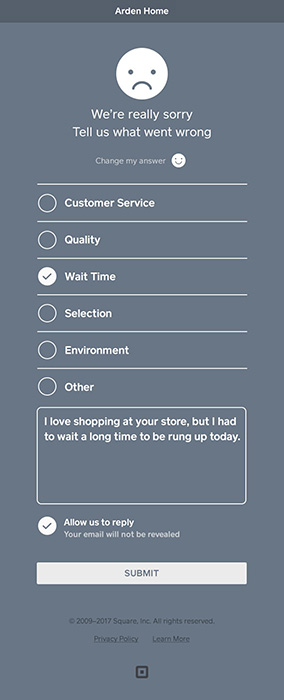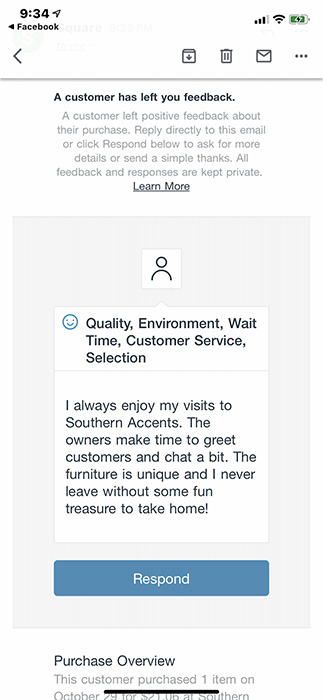Businesses that regularly collect customer feedback outperform businesses that don’t. Using CSAT surveys is easy and can give you immediate, actionable feedback.
Customer Satisfaction Survey Templates & Top Questions to Ask
This article is part of a larger series on Retail Management.
A customer satisfaction (CSAT) survey is a questionnaire that businesses send to shoppers after they have made a purchase or received a service from your business. It is designed to capture sentiment around a particular product or experience rather than overall loyalty to your business.
We’ve included two downloadable survey templates just below. Our guide will also cover how CSAT surveys work, what questions to ask, some best practices, and how to get started using customer satisfaction surveys in your business.
Simple & Detailed Survey Templates
Below is our free CSAT survey template that just includes the primary question: How would you rate your overall satisfaction with the products/service you received?
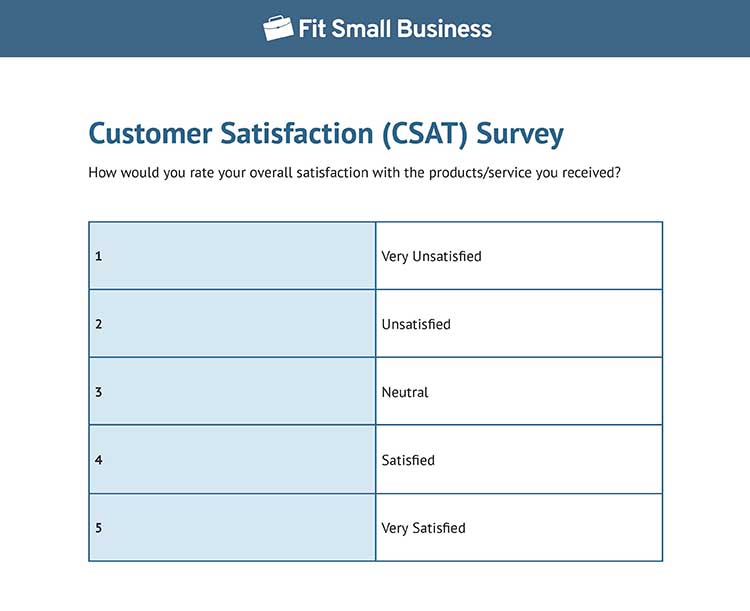
Thank you for downloading!
Want to automate your feedback collection for free? Square POS automatically requests customer feedback after each transaction with its digital receipts. Visit Square to learn more.
Here, we have a survey template that incorporates multiple types of survey questions, including Net Promoter Score (which we detail below), which you can customize to offer more specific insights.
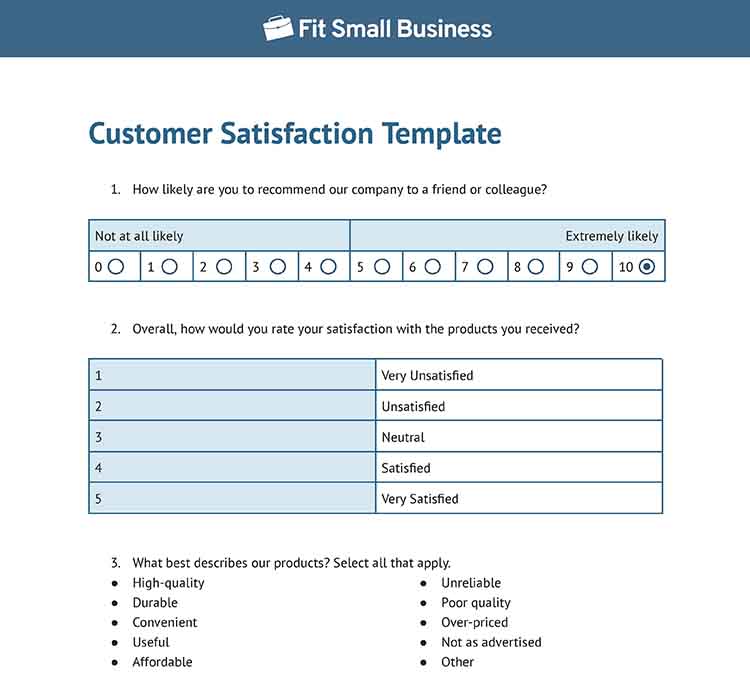
Thank you for downloading!
Want to automate your feedback collection for free? Square POS automatically requests customer feedback after each transaction with its digital receipts. Visit Square to learn more.
How Do Customer Satisfaction Surveys Work?
Typically, a customer satisfaction survey is used to calculate a satisfaction score by asking customers, “How satisfied are you with [product, experience, etc.]?”
Customers would then choose from the following 1–5 scale:
1. Very unsatisfied
2. Unsatisfied
3. Neutral
4. Satisfied
5. Very satisfied
Only customers who choose “Satisfied” or “Very Satisfied” are considered satisfied customers.
To calculate your business’ CSAT score, take your number of satisfied customers and divide it by the total number of survey respondents, then multiply by 100. Therefore, if you have 100 survey respondents and 70 of them responded “Satisfied” or “Very Satisfied” your CSAT score would be 70%.
Want to automate your feedback collection? Square POS automatically requests customer feedback after each transaction with its digital receipts. The feedback is tied with transaction records, and you can easily communicate with customers directly from the Square POS dashboard, as well as track your customer satisfaction over time. Visit Square to create your free account.
Other Types of Customer Satisfaction Surveys
In addition to the traditional CSAT survey, which we’ve described above, businesses can use more specific types of customer satisfaction surveys to drill down into customer loyalty, thoughts on new products, and website feedback, among other areas.
| Type of Survey | |
|---|---|
Net Promoter Score (NPS) Survey | To measure customer loyalty |
Post-purchase Survey | To get feedback on a particular experience |
Product or Service Development Survey | To gauge customer response to a new product before launching |
Usability Survey | For online businesses to get feedback on their website |
Net Promoter Score (NPS) Survey
An NPS or Net Promoter Score survey measures customer loyalty by asking a single question: How likely is it that you would recommend our company/product/service to a friend or colleague? Customers can score from 0 (not at all likely) to 10 (extremely likely).
Businesses use NPS to measure customer loyalty and overall customer sentiment instead of feedback on a specific product or experience. NPS is widely used across many industries, so it can be a good tool for measuring customer loyalty and satisfaction against competitors. NPS can also be used to identify detractors or customers likely to switch to competitors or spread negative feedback about your business.
NPS surveys are typically sent out to customers through email surveys or text messages. However, sometimes for online businesses, they also appear as a pop-up or chat box on the site. AskNicely is one example of a customer feedback software that collects NPS data and provides businesses with NPS insights.
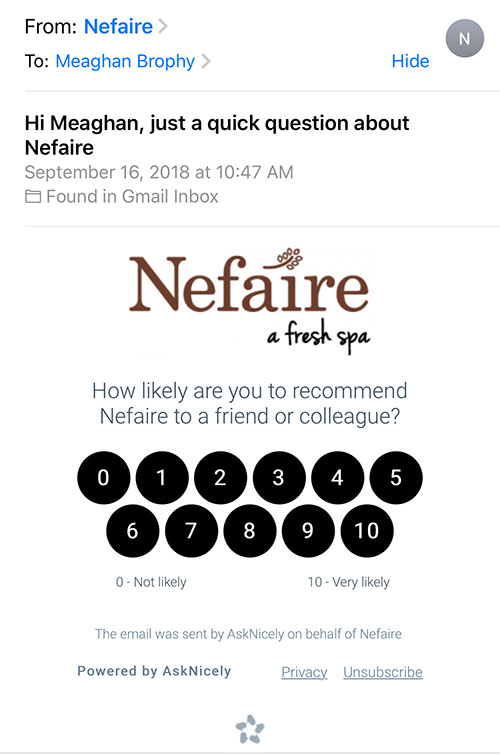
Example of an NPS survey
Customers are placed into three categories based on how they answer that question:
- Detractors: Customers who respond between 0–6 are considered detractors. Not only are you at risk of losing these customers, but they are also likely to impede the growth of your business through negative word-of-mouth.
- Passives: Customers who respond between 7–8 are considered passive customers. They are satisfied with your business but are not raving fans. Passives could either leave your business for a competitor or become raving fans.
- Promoters: Customers who respond between 9–10 are considered promoters. These are loyal customers who are likely helping to grow your business through referrals.
To calculate your Net Promoter Score, subtract the percentage of Detractors from the percentage of Promoters. For example, let’s say you have 100 survey results and 10 scored between 0–6, 20 scored between 7–8, and 70 scored between 9–10.
You would have:
- 10% Detractors
- 20% Passives
- 70% Promoters
70% Promoters – 10% Detractors = 60% So, your Net Promoter Score (NPS) would be 60.
Your NPS score can be anywhere from -100 to 100. Any positive NPS score is considered good, above 50 is considered great, and above 70 is considered world-class. For small businesses, NPS is a great tool to identify and reward your loyal customers as well as identify any unhappy customers to improve their experience.
Post-purchase Surveys
Post-purchase surveys are sent to customers after they have bought a product or a service from your company. These types of surveys are meant to get feedback on the specific experience the customers had with this transaction, as opposed to a survey like NPS, which gauges overall loyalty.
This type of survey should be used to pinpoint specific areas of the business that need to be improved. For example, if your NPS score is low, using post-purchase surveys helps businesses understand whether they need to focus their attention on their customer service or the quality of products.
Post-purchase surveys can be open-ended, but typically they ask customers to rank different aspects of their experience on a scale of “Strongly Disagree” to “Strongly Agree” or “Poor” to Excellent.” Since these surveys can be longer than one question, they are typically sent via a link in an email.
Product or Service Deployment Survey
Also known as Concept Testing, development surveys are sent to customers before businesses launch a new product to get a feel for how likely existing customers are to purchase the product. The goal of a product development survey is to see if the new product or service is profitable and/or receive feedback to make improvements to the product before launching it.
For this survey, you want to show customers a sample of the product you are testing, either in person or online, including price. Then, ask questions to gauge their reactions to the product and leave space for open-ended feedback. These surveys are best to send to your most loyal and highest-spending customers.
Usability Surveys
Usability surveys, or user experience surveys, are used by online businesses to receive feedback on their website to create a better experience for the customer. These surveys usually pop up while a shopper is on your site. They can be multiple-choice questions, open-ended questions, or even live messaging that directs shoppers to the information they are looking for.

Sample customer support chat
Usability surveys are best for trying to improve the customer experience, streamline content, or improve website navigation. There are many survey and messaging tools that can help collect customer feedback and provide a better shopping experience.
Supplemental Customer Satisfaction Questions to Ask
The questions we cover above are the main questions for any traditional CSAT survey. However, you can supplement with additional questions for more details and data points.
For example, demographic data around education, income, age, or location can help you identify trends, as can questions about product usage, psychology, and behavior.
Additional customer satisfaction survey questions include:
Demographics:
- What is the highest level of education you have received?
- What is your estimated annual household income?
- What is your age?
- What is your employment status?
Product Usage and Quality:
- How often do you use/purchase our products?
- What specific features do you find most valuable?
- Are there any features of our products/aspects of our business that you find frustrating?
- Would you say our pricing is competitive compared to similar products?
Shopper Psychology and Behavior:
- How did you hear about us?
- How did you research before deciding to purchase our product?
- Have you made an unplanned or impulse purchase from our business?
- What motivated you to make this purchase?
Targeted Customer Satisfaction Questions:
- Did our products meet your expectations? Why or why not?
- Did you encounter any difficulties during or after the purchasing process?
- Do you have any suggestions for improvement?
- Is there anything specific you liked about our products?
Customer Satisfaction Survey Best Practices
Getting clear, actionable feedback is the goal of customer surveys. There are a few simple steps you can take to make the most out of your surveys:
Ask One Question at a Time
Make sure there is only one variable in each question. For example, asking “How satisfied are you with our product selection and pricing?” asks customers to rate two separate elements in one answer. This could lead to inaccurate results and customers being unsure how to answer.
The better alternative is to ask separate questions: “How satisfied are you with our product selection?” and “How satisfied are you with our pricing?”
Don’t Require Customers to Answer Every Question
If your survey contains multiple questions, don’t require customers to answer every question in order to complete the survey. If customers are forced to answer a question they are unsure of, they will likely abandon the survey altogether. Instead, make each question optional and include a space for comments after each question or at the end of the survey.
Limit Open-ended Questions
It’s important to have space for comments if customers want to write them. But, limit the number of open-ended questions. If your survey feels like work, customers won’t take the time to complete it. Shorter surveys with multiple-choice questions will yield the most response.
Balance Your Macro & Micro Response to Feedback
Addressing individual customer concerns quickly and directly is important for loyalty and retention. However, compiling feedback to spot larger trends will help you make smart business decisions moving forward.
Time Your Surveys Right
It’s important to solicit feedback while the experience is fresh in customers’ minds. However, one very common mistake businesses make is sending out surveys before customers have even received the product.
If your products are shipped to customers or take some time to really use or consume, consider sending your survey a week or two later. Mistimed surveys can create a poor customer experience, especially if those customers are waiting on their orders.
Find out more about measuring customer satisfaction to improve the quality of customer service for your business.
How to Integrate Customer Satisfaction Surveys into Your Business
While there are specific instructions for each type of survey, businesses should follow some general guidelines with any customer satisfaction survey to ensure a smooth and effective process. For example, determining your goal for the survey ahead of time and getting all of your employees on board are crucial steps for a successful survey.
Here are six steps every business should follow when setting up a customer satisfaction survey:
Step 1: Determine Your Need
Before you begin, it is important to pin down exactly why you need this survey and what insights you want to get out of the survey results. For example, if you are trying to reduce your customer churn rate, a product development survey won’t be as helpful as an NPS survey. By determining your need for the survey first, you can choose the survey type that will give you the most relevant data.
Step 2: Choose a Medium
After determining your need and choosing a survey type, you must pick a medium. Will you be sending your survey over email, text, in-app, on paper, or in person? Most surveys are collected over email, but some product development surveys could be done in person. Surveys that measure a website’s ease of use can be done as pop-up surveys on the site itself.
Step 3: Select a Survey Tool
Once your survey type and delivery method are chosen, it’s time to pick a survey tool that can accommodate the type of survey you are looking to deploy. Obviously, price is a big consideration, but also consider whether this is a one-off survey or if you want to incorporate customer satisfaction surveys into your business indefinitely.
There are some free and low-cost online tools you can use. However, if surveys are an ongoing part of your strategy, consider looking into solutions that are either built-in to any existing solutions you’re already using (point-of-sale, CRM, ecommerce, etc.) or can be easily integrated.
Step 4: Set a Process
After you have your survey type, medium, and software in place, it’s time to set a process for executing your survey. If you are doing a survey with custom questions, this is when you would sit down and create them. This is also when you determine during what part of the buying process shoppers will receive their surveys. Be sure to show a copy of the survey to your employees and let them know what their role is in the process if they have one.
Step 5: Gather Feedback
Now that your survey is in place, start monitoring your results. Check feedback regularly for any common themes or customer service opportunities. If your survey tool gathers and analyzes data for you, make sure your employees have access to see the customers’ feedback. If your survey tool doesn’t package feedback for you, manage the feedback yourself with a spreadsheet or CRM software and set regular times to share feedback with your staff.
Step 6: Enact Change
Going through this process of setting up surveys and collecting feedback is only worthwhile if you gain actionable insights for your business. Take the common themes you notice from the surveys to change business policies, better train employees, or adjust your products and services.
Customer Satisfaction Survey Frequently Asked Questions (FAQs)
Most businesses emphasize that the survey results are used to improve their products and services, which can be a direct benefit for the customer. For detailed or lengthy surveys, some businesses offer a discount code for customers that complete the survey or enter those customers into a raffle contest.
You want to ask customers for feedback while the experience is fresh in their minds. Ideally, within 24 hours of their purchase while they still remember all the details. For online purchases, send the survey a day or two after the customers receive their items.
Send out customer satisfaction surveys no more than once per transaction. Sending surveys more frequently than that can become confusing. Generally speaking, you want to send out surveys often enough to have updated information, but not so often that they annoy the customer.
In order to be able to compare survey results over time with accuracy, you need to stick with the same exact survey. So, if you change the introduction to the survey, its delivery method, or any of the questions, you will essentially start over with your tracking. That is why it’s important to carefully plan out your customer satisfaction survey before executing.
Bottom Line
Customer satisfaction surveys are an important tool for every business. They collect honest feedback to improve services, increase customer satisfaction, and build loyalty. Customer satisfaction surveys can be as complex or as simple as you want them to be—just make sure whatever type of survey you use is a process you can consistently follow through on.

